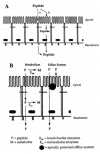Targeting receptors, transporters and site of absorption to improve oral drug delivery
- PMID: 21901064
- PMCID: PMC3155234
Targeting receptors, transporters and site of absorption to improve oral drug delivery
Abstract
Although the oral route of drug administration is the most acceptable way of self-medication with a high degree of patient compliance, the intestinal absorption of many drugs is severely hampered by different biological barriers. These barriers comprise of biochemical and physical components. The biochemical barrier includes enzymatic degradation in the gastrointestinal lumen, brush border and in the cytoplasm of the epithelial cells as well as efflux transporters that pump drug molecules from inside the epithelial cell back to the gastrointestinal lumen. The physical barrier consists of the epithelial cell membranes, tight junctions and mucus layer. Different strategies have been applied to improve the absorption of drugs after oral administration, which range from chemical modification of drug molecules and formulation technologies to the targeting of receptors, transporters and specialized cells such as the gut-associated lymphoid tissues. This review focuses specifically on the targeting of receptor-mediated endocytosis, transporters and the absorption-site as methods of optimizing intestinal drug absorption. Intestinal epithelial cells express several nutrient transporters that can be targeted by modifying the drug molecule in such a way that it is recognized as a substrate. Receptor-mediated endocytosis is a transport mechanism that can be targeted for instance by linking a receptor substrate to the drug molecule of interest. Many formulation strategies exist for enhancing drug absorption of which one is to deliver drugs at a specific site in the gastrointestinal tract where optimum drug absorption takes place.
Keywords: Oral drug delivery; absorption enhancement; active transporters; receptor-mediated endocytosis; site-specific drug delivery.
Figures

Similar articles
-
Intestinal Absorption Study: Challenges and Absorption Enhancement Strategies in Improving Oral Drug Delivery.Pharmaceuticals (Basel). 2022 Aug 8;15(8):975. doi: 10.3390/ph15080975. Pharmaceuticals (Basel). 2022. PMID: 36015123 Free PMC article. Review.
-
Strategies and Mechanism in Reversing Intestinal Drug Efflux in Oral Drug Delivery.Pharmaceutics. 2022 May 26;14(6):1131. doi: 10.3390/pharmaceutics14061131. Pharmaceutics. 2022. PMID: 35745704 Free PMC article. Review.
-
Targeting intestinal transporters for optimizing oral drug absorption.Curr Drug Metab. 2010 Nov;11(9):730-42. doi: 10.2174/138920010794328850. Curr Drug Metab. 2010. PMID: 21189135 Review.
-
The human intestinal epithelial cell line Caco-2; pharmacological and pharmacokinetic applications.Cell Biol Toxicol. 1995 Aug;11(3-4):187-94. doi: 10.1007/BF00756522. Cell Biol Toxicol. 1995. PMID: 8564649 Review.
-
[Molecular characterization of intestinal absorption of drugs by carrier-mediated transport mechanisms].Yakugaku Zasshi. 1997 Jul;117(7):415-34. doi: 10.1248/yakushi1947.117.7_415. Yakugaku Zasshi. 1997. PMID: 9261213 Review. Japanese.
Cited by
-
Transport of nanocarriers across gastrointestinal epithelial cells by a new transcellular route induced by targeting ICAM-1.J Control Release. 2012 Oct 10;163(1):25-33. doi: 10.1016/j.jconrel.2012.06.007. Epub 2012 Jun 12. J Control Release. 2012. PMID: 22698938 Free PMC article.
-
Chitosan-Alginate Microcapsules Provide Gastric Protection and Intestinal Release of ICAM-1-Targeting Nanocarriers, Enabling GI Targeting In Vivo.Adv Funct Mater. 2016 May 24;26(20):3382-3393. doi: 10.1002/adfm.201600084. Epub 2016 Apr 23. Adv Funct Mater. 2016. PMID: 27375374 Free PMC article.
-
Oral delivery of glucagon-like peptide-1 and analogs: alternatives for diabetes control?J Diabetes Sci Technol. 2012 Nov 1;6(6):1486-97. doi: 10.1177/193229681200600630. J Diabetes Sci Technol. 2012. PMID: 23294796 Free PMC article. Review.
-
Effect of surface chemistry on nanoparticle interaction with gastrointestinal mucus and distribution in the gastrointestinal tract following oral and rectal administration in the mouse.J Control Release. 2015 Jan 10;197:48-57. doi: 10.1016/j.jconrel.2014.10.026. Epub 2014 Nov 4. J Control Release. 2015. PMID: 25449804 Free PMC article.
-
Challenges and Opportunities in the Oral Delivery of Recombinant Biologics.Pharmaceutics. 2023 May 5;15(5):1415. doi: 10.3390/pharmaceutics15051415. Pharmaceutics. 2023. PMID: 37242657 Free PMC article. Review.
References
-
- Ambudkar SV, Kim IW, Sauna ZE. The power of the pump: Mechanisms of action of P-glycoprotein (ABCB1) Eur J Pharm Sci. 2006;27:392–400. - PubMed
-
- Aungst BJ. Novel formulation strategies for improving oral bioavailability of drugs with poor membrane permeation or presystemic metabolism. J. Pharm. Sci. 1993;82(10):979–87. - PubMed
-
- Aungst BJ. Intestinal permeation enhancers. J. Pharm. Sci. 2000;89(4):429–42. - PubMed
-
- Banerjee D, Flanagan PR, Cluett J, et al. Transferrin receptors in the human gastrointestinal tract. Gastroenterology. 1986;91:861–9. - PubMed
-
- Bardonnet PL, Faive V, Pugh WJ, et al. Gastroretentive dosage forms: Overview and special case of Helicobacter Pilori. J. Control Release. 2006;111:1–18. - PubMed
LinkOut - more resources
Full Text Sources
Other Literature Sources

